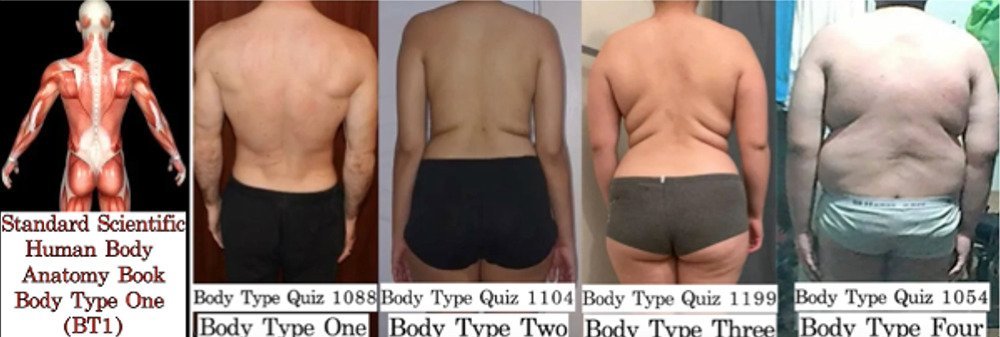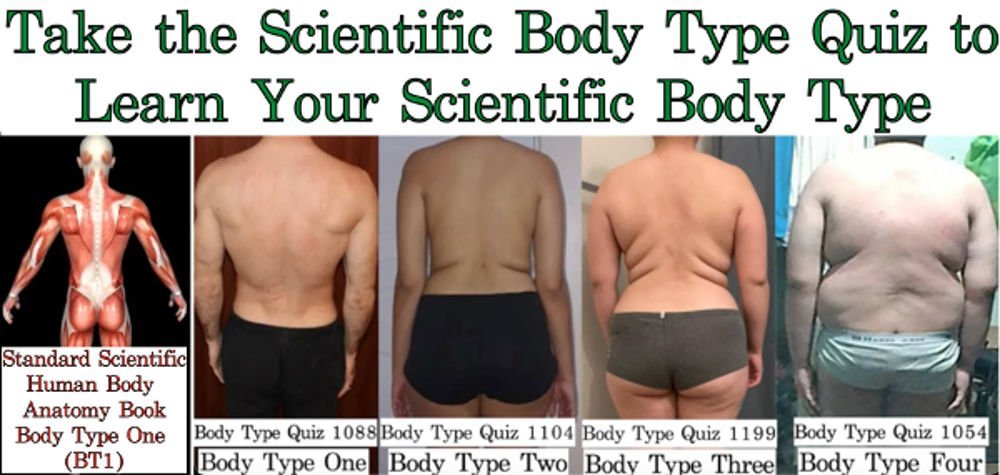
 Muscle loss and muscle gain science starts with genetics (DNA). It is a genetic fact that any part of the human body can be underdeveloped, to whatever degree, including muscles and muscle mass. If you are experiencing genetically underdeveloped default muscle/mass, you most likely have some type(s) of skinny fat (cellulite, thin fat, loose skin, saggy skin, crepey skin, normal weight obesity) where that default muscle/mass should be. If you have any type(s) of skinny fat on your body, then it is likely that you have had genetically underdeveloped muscle/mass since birth.
Muscle loss and muscle gain science starts with genetics (DNA). It is a genetic fact that any part of the human body can be underdeveloped, to whatever degree, including muscles and muscle mass. If you are experiencing genetically underdeveloped default muscle/mass, you most likely have some type(s) of skinny fat (cellulite, thin fat, loose skin, saggy skin, crepey skin, normal weight obesity) where that default muscle/mass should be. If you have any type(s) of skinny fat on your body, then it is likely that you have had genetically underdeveloped muscle/mass since birth.
It is a fact that the human body will always burn regular fat (fat/white fat/yellow fat/excess fat/adipose tissue/being overweight or obese) and calories consumed (food and drink) first before it ever burns a very valuable resource like genetic default muscle/mass. Too many people on social media are pushing false ideas — total nonsense — that the human body just casually burns super valuable genetic default muscle/mass, especially when dieting.
Wrong, it does not. If you lost weight and are then “missing” muscle/mass, it is more likely that you never had that genetic default muscle/mass to begin with thanks to your genetics and one or more of the six types of skinny fat.
If your body is to a point where it is burning default genetic muscle/mass because of your diet, then you are inappropriately and unsafely starving your body which means you have a very poor diet that is super unhealthy. Being bedridden for an unusually long period of time due to illness or injury can also cause muscle/mass decline. As can rare genetic disorders and age.
Protect & Maintain Genetic Default Muscle/Mass – Muscle Versus Fat
Eat high-quality (whole, preferably organic) nutrient-rich food daily including protein, fats, and carbohydrates (more fiber, less sugar) to maximize nutrition, minimize calories, and maintain muscle/mass. Although, intermittent fasting (IF), when done appropriately and safely, can have beneficial health effects. Following a healthy exercise (cardio & resistance) routine and lifestyle (sleep, stress, career, etc.) are vital.
 It is important to note that it is not possible to turn muscle into fat, any more than it is to turn fat into muscle. Fat cells and muscle cells are different structures and are not interchangeable. Muscle does not “turn into fat.” Period. There is no process in the human body by which muscle – which is made up of mainly protein, amino acids, and water – transforms itself into any of the four kinds of fat, be it regular fat, skinny fat, brown fat, or beige fat. The human body, no matter how amazing it can be at times, cannot magically turn one tissue into another.
It is important to note that it is not possible to turn muscle into fat, any more than it is to turn fat into muscle. Fat cells and muscle cells are different structures and are not interchangeable. Muscle does not “turn into fat.” Period. There is no process in the human body by which muscle – which is made up of mainly protein, amino acids, and water – transforms itself into any of the four kinds of fat, be it regular fat, skinny fat, brown fat, or beige fat. The human body, no matter how amazing it can be at times, cannot magically turn one tissue into another.
Thus, no amount of dieting, no amount of lifestyle changes, and no amount of exercise (resistance or cardio)/effort in the gym will fix/get rid of or change/turn/transform/translate skinny fat into muscle/mass. The best you can do is reduce skinny fat and manage it through lifestyle, exercise, and diet. Understanding your genetic scientific body type, one of The Four Body Types (as per the Body Type Science theory), helps you accept your genetic body for what it is to figure out the best science-based diet, exercise, and lifestyle to be as healthy as possible in the short and long term.
Muscle Loss & Muscle Gain Science – Genetic Scientific Standard Body Type One (BT1) & Developed Muscles/Muscle Mass
The genetic scientific Standard Body Type One (BT1) — found in any scientifically approved human body anatomy book and the only body type recognized and used by mainstream science and medical doctors to determine whether a human body is “normal” and healthy, along with the inaccurate Body Mass Index (Standard BMI) and basal metabolic rate (Standard BMR) — genetically has fully developed muscle/mass. Muscle plays many vital roles in the functioning and health of the human body.
Every vertebra houses a specific set of muscles, and if any of those muscles are underdeveloped it directly affects posture in a negative way. Muscle serves as armor while also being responsible for movement, strength, speed, agility, athleticism, and heat, no less.

Muscle loss and muscle gain science currently recognizes that daily, muscle/mass burns six (6) calories per pound whereas regular fat and skinny fat only burn two (2) to three (3) calories per day per pound. This directly, negatively affects metabolism, in that the more skinny fat and/or regular fat you have on your body, the slower your metabolism. A slow metabolism means your body burns fewer calories making you more prone to putting on excess fat weight.
Moreover, anywhere your body has genetically underdeveloped muscle/mass and in place of that muscle/mass is skinny fat, the tendency increases that you will put on excess regular fat weight in those areas. Most people fail to realize that regular fat and skinny fat are two different kinds of fat. At this time, science does not know why molecularly, but there are clear, indisputable differences between the two types of fat.
The Difference Between Regular Fat and Skinny Fat (6 Types) – Muscles & Muscle Mass Cellular Regeneration
The most obvious difference is that it is 100% possible to get rid of/lose regular fat through natural body processes. In other words, through proper science-based diet, exercise, and lifestyle you can lose excess regular fat weight and keep it off in the short and long term. But, it is 0% possible to fix/get rid of/lose any type of skinny fat. There is no FDA-approved way to get rid of cellulite or any other type of skinny fat; you can only reduce it at this time. As Body Type Science grows, it will be interesting to see what the scientific data reveals at the molecular level in terms of regular fat versus skinny fat.

As mentioned, it is a fact that no amount of weightlifting will transform skinny fat into muscle. Any muscle/mass that you do add through weight training that is above and beyond your genetic default muscle/mass will gradually be lost once you stop lifting weights. For most people, you will begin to lose added muscle/mass 2-4 weeks after stopping, eventually returning to your genetic default muscle/mass.
As well, people 40 years and older begin to experience a decline in the efficiency and effectiveness of their cellular regeneration. This means that because of your genetics, your cells do not replicate as efficiently and completely as they did when you were younger (less than 40 years old). This cellular regeneration inefficiency leads to a slight but gradual decline of body mass including muscle/mass as the years pass, which is aggregate over time.
The older you get, the more inefficient and effective your cellular replication becomes which leads to the increased prominence of senescent cells and sarcopenia, and, thus, typically muscles/mass and collagen are some of the most obvious declines. The loss of no less than muscle/mass and collagen increases the appearance of aging including skin wrinkles and sagging, in general, while decreasing the strength and movement ability of the body, no less. Resistance exercises like weight lifting will help combat this decline of muscle/mass, but routines along with diet and lifestyle must be adjusted properly relative to age and unique genetic body composition.
Genetic Scientific Body Type (The Four Body Types) – Muscle Loss & Muscle Gain Science
Identifying your genetic scientific body type, one of The Four Body Types, will help you better understand your genetically developed muscle/mass (or lack thereof) relative to skinny fat and regular fat on your body. Are you a Standard Body Type One (BT1), Body Type Two (BT2), Body Type Three (BT3), or Body Type Four (BT4)?
Human Vertebrae (26): 7 Cervical, 12 Thoracic, 5 Lumbar, 1 Sacrum, 1 Coccyx
- Body Type One (BT1) – 0 Vertebrae Underdeveloped Relative to Muscles/Muscle Mass and Skinny Fat (All 26 Vertebrae Developed)
- Body Type Two (BT2) – 1-8 Vertebrae Underdeveloped Relative to Muscles/Muscle Mass and Skinny Fat (Between 25 and 18 Vertebrae Developed)
- Body Type Three (BT3) – 9-17 Vertebrae Underdeveloped Relative to Muscles/Muscle Mass and Skinny Fat (Between 17 and 09 Vertebrae Developed)
- Body Type Four (BT4) – 18-26 Vertebrae Underdeveloped Relative to Muscles/Muscle Mass and Skinny Fat (Between 08 to 0 Vertebrae Developed)
The Fellow One Research Scientific Body Type Quiz determines your genetic scientific body type along with your proprietary scientifically reckoned metabolism scores including adjusted BMR (Mifflin) and activity metabolic rate (Harris-Benedict). As well, the Quiz scientifically calculates proprietary health scores in relation to the latest science-based diet, exercise, and lifestyle data. Learn more about the Body Type Science research data.



